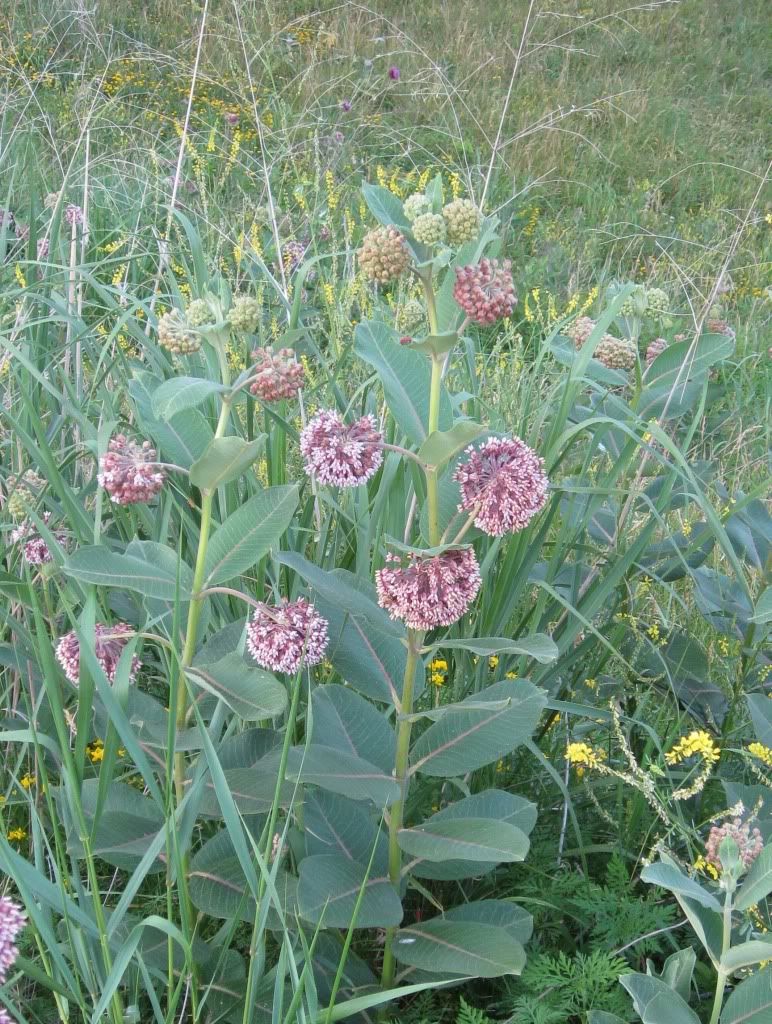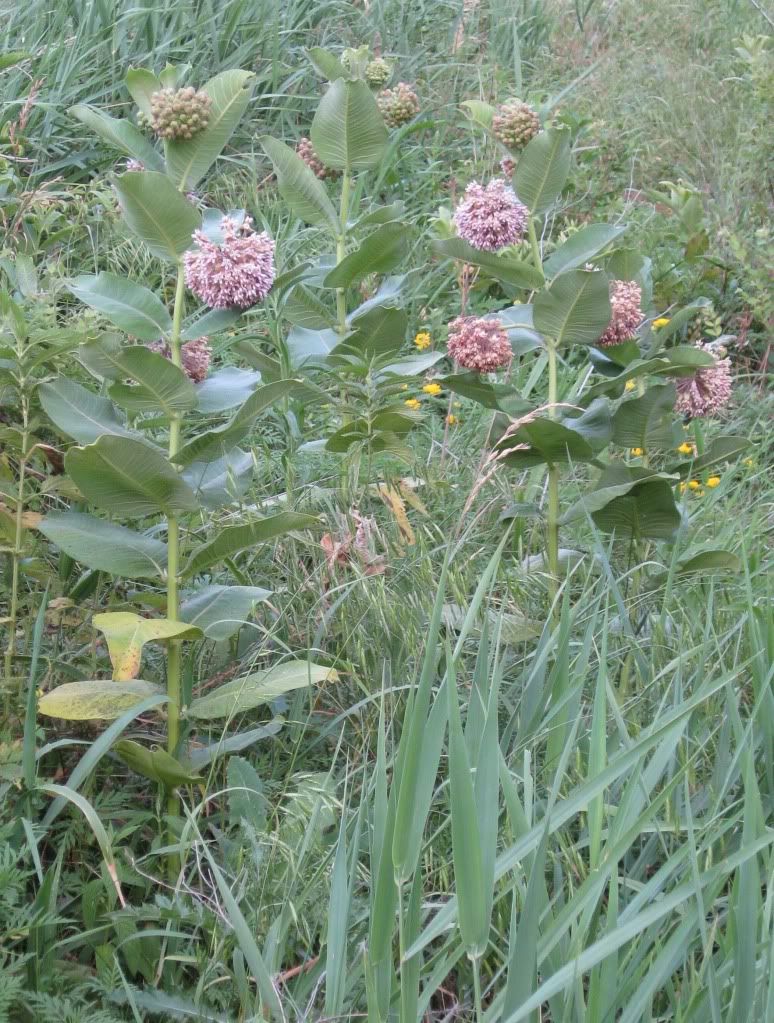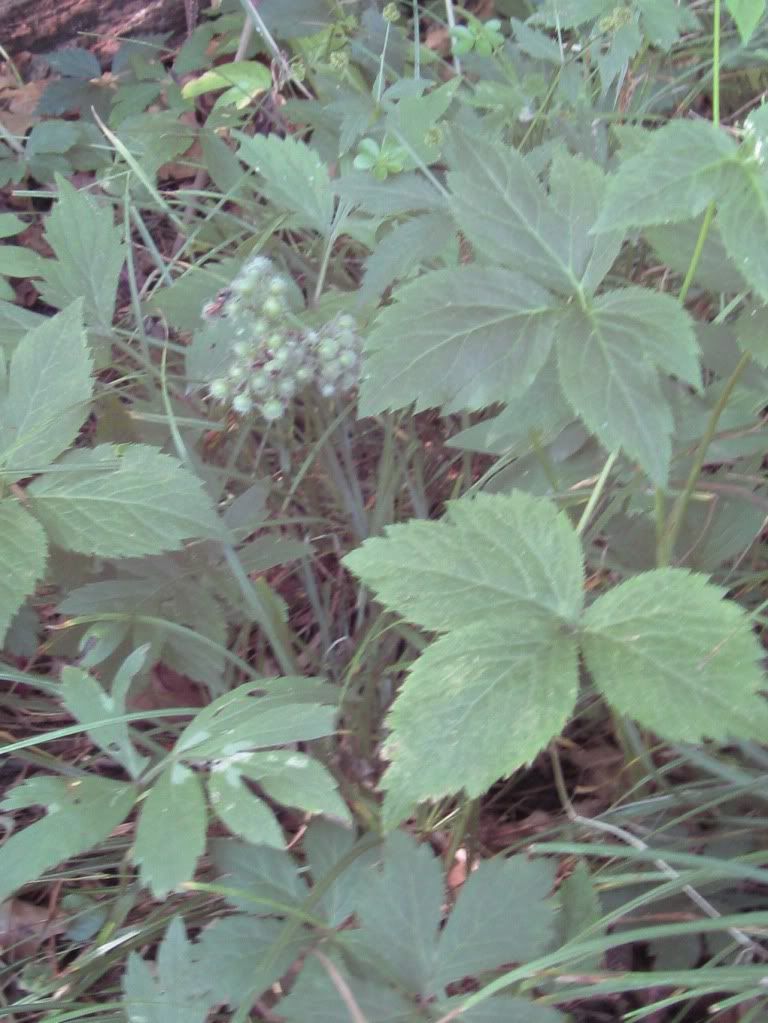Of the 17 types of milkweed found in Iowa, common milkweed is by far the most widespread. The use of genetically-modified Roundup Ready corn and soybeans greatly diminished common milkweed on Iowa cropland, but if you ever drive or ride your bike in the countryside, you’ve probably seen this plant along the side of the road. Common milkweed grows along many city bike trails too. I’ve posted a couple of photos after the jump, along with a bonus shot of Virginia waterleaf after the flowers have gone.
This is an open thread: all topics welcome.
Milkweed gets its name from the white sap that flows from the plant if you break off a leaf or part of the stem. More than 450 different kinds of insects can feed on milkweed. The plant is famously the exclusive food of monarch butterfly larvae (caterpillars).
Milkweed flowers have five petals pointing up and five pointing down. Common milkweed
can be distinguished from other milkweeds by its purplish flowers that form ball-shaped clusters and large teardrop-shaped seed pods covered with warty bumps. After pods mature in autumn, they split lengthwise releasing numerous tufted seeds. […]
Common milkweed blooms from June to August. Seedlings do not flower until the second year. Usually, 1 or 2 flowers in each cluster mature into a seed pod. It has been estimated that a single common milkweed plant can produce 25 fruits and each fruit contains as many as 450 seeds. Seeds can float and fly and have been reported to survive at least 3 years buried in soil. Roots can grow 13 feet deep and the length of horizontal roots can increase up to 10 feet in a single season. A piece of root about 1 inch in length can produce a new plant.
I’ve seen tons of common milkweed blooming during the past couple of weeks.
I think the darker pink flower blooming in the far background is bull thistle, an invasive plant that’s on Iowa’s noxious weed list. Bull thistle can be seen along nearly as many roadsides as common milkweed. It may be Canada thistle, which is also widespread and on the noxious weed list.
The tall plant with yellow flowers blooming just to the right of the milkweed and in the mid-background of this photo is yellow sweet clover. It’s native to Asia and has become a common pasture crop in North America.
The yellow flowers blooming just behind the milkweed and in the far back, to the left of the thistle, are bird’s-foot trefoil. This plant is native to Europe and considered invasive in some parts of the U.S. On the other hand, many American cattle farmers consider bird’s-foot trefoil an excellent pasture crop.
Here’s another shot of common milkweed, with bird’s-foot trefoil in the background. The clusters of buds near the top of the milkweed will bloom during the next few weeks.
Milkweed plants like sunny areas or light shade.
Todays’ bonus photo shows clusters of fruit on Virginia waterleaf, which Bleeding Heartland featured in bloom here. The fruit isn’t edible and looks more like peas or seeds. Each of these capsules contains two or four seeds. Near the bottom of the picture you can see a leaf that looks like it’s been splashed with water, one of the easiest ways to identify this plant.




9 Comments
Butterflies
We let our milkweed grow this year to try attracting butterflies. We don’t quite have blooms yet, but they should appear any day now.
Are there other good butterfly-attracting plants that we can grow?
corncam Wed 20 Jun 9:38 PM
good luck
don’t know about the plants, but I’ve heard that sticking a few upside-down wine bottles in the ground and putting some water in the depression can help attract butterflies. It’s like a mini-birdbath.
This site has other easy tips for attracting butterflies.
desmoinesdem Sun 24 Jun 8:52 AM
Mexican Sunflower
It’s also known as a tithonia and it got seven feet tall for us last summer. It attracted scads of butterflies by the end of the season as they swarmed its flowers all day. Plant some next year.
iowavoter Tue 26 Jun 8:32 AM
Dill and parsley
attract swallowtails. Sedum “Autumn Joy” attracts little orange speckled butterflies. Not sure what they are. Butterfly bush, of course.
2laneia Thu 21 Jun 3:26 PM
I didn't know that
about dill and parsley. Thanks for the tip. People can grow those in small pots on a deck or windowsill.
desmoinesdem Sun 24 Jun 8:50 AM
M'GOSH!!! ROADMAPGATE
. . . swirling up in Bremer County like a hot-wind dust storm and about to bring down possibly every politician in the State, and we’re talkin weeds! Heh-hee
conservative-demo Thu 21 Jun 3:34 PM
don't know about roadmapgate
but if you’re in Bremer County, watch for the black bear recently spotted in the area!
desmoinesdem Sun 24 Jun 8:55 AM
Speaking of plants and bugs
Yesterday I was at Lowes and bought a trap for Japanese Beetles. I hung it out this morning and just now after supper I emptied it into a gallon-size zip-lock freezer bag and got more than half a gallon of the beetles. That trap is fantastic.
I double bagged the beetles to prevent critters from going after the bag and I will put it out with the garbage on Tuesday.
Hah, at that rate I may need to buy another new box of gallon freezer bags.
conservative-demo Wed 27 Jun 7:13 PM
Bird's-foot trefoil and yellow sweet clover
Both of these plants are invasive problems in native prairies and prairie plantings. They aren’t as bad as crown vetch, which is a much worse problem, but they are problems. Bird’s-foot is worse because it’s harder to pull or dig. But many prairie managers have spent hours of our lives pulling and mowing and whacking white and yellow sweet clover. My husband hates the smell of it now, and seeing it makes me just want to grab and yank, pretty though it is.
PrairieFan Tue 25 Apr 10:58 PM